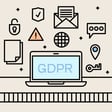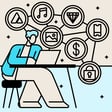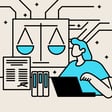Become a Creator today!Start creating today - Share your story with the world!
Start for free
00:00:00
00:00:01

Ep 39: Tokenizing Securities for Decentralized Finance Applications
Professor Andreas Park from the University of Toronto discusses how blockchain can transform the trading and management of securities. In this episode, he shares his research on overcoming the complex challenges of integrating stocks, dividends, and voting rights into decentralized systems, offering insights into the future of finance.
Learn more in his paper: https://edas.info/showPaper.php?m=1571031828
Transcript
Introduction to the Owl Explains Hootenanny Podcast
00:00:06
Speaker
Hello and welcome to this Owl Explains Hootenanny, our podcast series where you can wise up on blockchain and web3 as we talk to the people seeking to build a better internet. Owl Explains is powered by Avalabs, a blockchain software company and participant in the avalanche ecosystem.
Guest Introduction: Professor Andreas Park
00:00:24
Speaker
My name is Silvia Sanchez, project manager of Owl Explains and with that I'll hand it over to today's amazing speakers.
00:00:34
Speaker
Hey, everybody. It's time for the Owl Explains podcast. Today, you've got Lee Schneider hosting and our guest, Professor Andreas Park from the University of Toronto Rotman Business School. ah Andreas, please introduce yourself
Blockchain's Impact on Finance: An Academic Perspective
00:00:49
Speaker
to everybody. Give give folks ah and a little bit of an idea of what ah you do and what your focus areas are. Well, thanks, Lee. And it's great talking to you. um Not really really sure what to say. I'm a professor at the University of Toronto. um I do research in a field called market structure. I've also worked in corporate finance and the like. And I mean, obviously, this is a this is a podcast on blockchain and kind of became my interest a few years ago when I realized that this is actually something really cool and new, which could transform the way how we think about finance. And I've done a number of papers on this topic.
00:01:29
Speaker
And the Owl Explains podcast is fortunate enough to have you for two sessions, one that I'm hosting and the other one that will be hosted by our normal host, Sylvia, who has a much better voice for podcasting, but I'll do my best that I can.
Tokenization of Securities: Research and Insights
00:01:45
Speaker
I fully agree with that, and I think it's going to be a lot of me, so sorry about that. No worries at all. That's that's why we've got you here. You've been doing some really interesting work, and so we're going to highlight we going to highlight two of the papers.
00:01:59
Speaker
One of them that the one that we'll highlight on this episode ah relates to actually how one does the implementation of ah securities on blockchain. So the tokenization of of actual securities like like equity security stocks ah for trading, etc. And so talk a little bit, Andreas, about the paper.
00:02:26
Speaker
and sort of how you had the original idea to do this research and and do this work. yeah so ok so if If I take a ah very big swing at this, um so taking a step back, that that I always thought that the really interesting thing about a blockchain is that you can think about it as a a decentralized value management infrastructure. um And the the cool thing about it is that it allows multiple parties to interact on a single system, um is to exchange assets and to exchange value, to pledge value and so on and so forth.
00:03:02
Speaker
And that's very much in contrast to our current world, where a lot of record-keeping and transfers have to happen offline, have to happen you know with a very difficult reconciliation process. There's uncertainty around, you need a lot of trust. A lot of things have to work together and have to be tightly, ah there has to be tight oversight to actually make sure that nobody can cheat.
00:03:28
Speaker
And I think a blockchain is just a great solution to to make a lot more happen.
Decentralized Value Management vs. Traditional Systems
00:03:33
Speaker
And so against this backdrop, um um my colleague, Katya and I, we we started thinking about, well, if we you know wanted to use real securities on the blockchain, how would that actually look like? And it turns out that that's not a very simple problem for a number of reasons. I mean, you know if you if you think about it, it's very easy to actually issue a token on a blockchain. That's that's not hard, right? So you can go to you know to Can Products for that and create an ERC20 token. And you know nothing prevents you to say, hey, this token is you know relates to an existing stock, for instance. That's not difficult. But if you actually want to
00:04:14
Speaker
really allow the features of of the blockchain to work and then also have the features of say a stock or share of a company where you have voting rights and we have rights to dividends and the like and have that work in an environment where there is DeFi solutions and where you have self custody of your assets. That's really not easy.
00:04:37
Speaker
So I think this is a great topic and and that's that's one of the reasons why we're doing this podcast. I spent a lot of my career working in equity markets and equity market structure and and sort of helping to think through these issues from a very practical operational standpoint when I worked with clearing brokers and and other ah other um broke ah banks and and other financial institutions.
00:05:05
Speaker
um And you know I used to be fond of saying the traders think they're hot stuff when they can trade a million shares of a stock. But really, the hard part is clearing and settling that transaction.
00:05:22
Speaker
And then when you add on top of that, whether or not the stock is being traded come dividend or ex dividend and all of the other attendant things that you just noted, it it really does point up the difficulties.
00:05:37
Speaker
that have had to be worked through in the traditional markets. um And so maybe spend two seconds talking about some of the solutions that traditional markets have enacted here as imperfect as they can be sometimes.
00:05:55
Speaker
Yeah, um so let me just say a few things about what you what you described there. um Just maybe for the audience, it's also useful to to know. we had a um We have an annual um meeting that used to be at the MBR and we had a presentation a few years back where ah folks a few folks from industry actually reported how much or how much val dollar value actually doesn't settle on any given day. And the numbers are quite staggering, right? It's in hundreds of millions of dollars that that don't settle for a large variety of reasons. And so this is actually a cool thing about blockchain is like you can actually make sure that the settlement happens and that you kind of know who owns water each time, right? As you say, just just to go to one of the points that you made, right? The ex cum dividend ownership of an asset
00:06:42
Speaker
that's ah That's a really complicated problem.
Dividend Distribution in Blockchain
00:06:45
Speaker
And it's a really meaningful problem because you need to know who holds an asset and you know how do you actually make sure that the dividend reaches the person who holds it at the time when the dividend is being issued. right um And so if you want, then that's actually even also one of the some of the problems that we face on the blockchain. um When you have an asset and it's supposed to be paying a dividend, you need to make sure that a person gets a dividend paid when they're actually the owner of ah of a share.
00:07:12
Speaker
um So let's let's just maybe look at the traditional assets. And Lee, you know, given your background, you probably know a lot more of it than I do. But the simple problem is this. ah Let's take an example. ah You have your shares, and yeah they sit at your brokerage. And normally what you do is you allow your brokerage to pledge these shares ah for short selling. So some other party can can borrow these shares and make a sale um so as to cover or to borrow these shares so they can cover a short position that they take in an asset.
00:07:41
Speaker
And that kind of makes it difficult to to make to reconcile of when you do this, for instance, at the day of a vote or when it happens across a date when a dividend be is being paid is who actually, where should the dividends actually go if you if you gave these shares to somebody else um so that they can use them for short selling.
00:08:02
Speaker
And so you know um so, how do we deal with this um you know in ah in a blockchain world is is and is a is pretty good question. right um Now, one of the things that is useful in a blockchain is that in principle,
00:08:17
Speaker
at any given point in time it's known who or at least point in time is maybe not the right and word here at any given block because you know blocks are happening in sequence and are sort of deterministic you would know who holds a particular token.
00:08:35
Speaker
right Except that it's not quite so clear and it can be difficult to account for when it comes to issues like decentralized finance applications where you have borrowing and lending pools or where you have liquidity pools for trading.
00:08:50
Speaker
and and so If you want to have tokenized assets and have a system in which you can use these tokenized assets within these tools, then we need to find a way how we can properly account for ownership given that um you know a token could be an illiquidity pool.
00:09:09
Speaker
now what What is the problem actually that arises here? Formally, what you do is when you take, um let's say, an older version of Uniswap V2, what you do is you put your assets in a liquidity pool and technically the assets are then owned by a smart contract. but They're not owned by your self-custody contract, but they're owned by a different contract. And so when you want to make a dividend payment,
00:09:35
Speaker
and you want to account for ownership, you kind of need to go one level further to figure out who is actually the owner behind a liquidity pool holding. and so That is not an easy process to do. and This is kind of where we're trying to think of a technological solution to this. I think it's a great example. and you know In traditional financial services,
00:09:57
Speaker
ah Most stocks sit at dtc or some other central counterparty and then everything flows down through the dtc members and so banks and broker dealers ah eventually finding its way hopefully to the right.
00:10:15
Speaker
ah owner of the stock. and And that's how the dividend payments get made. And that that that that's subject to difficulties and trouble all the time. ah Even in the just the simple case where I haven't loaned out my stock so that somebody could sell it short, i ah where I'm just holding my stock. But then you add the additional complication of somebody who um is ah is doing it, has loaned out their stock and and there's a short sale. um So you have a tracing problem in the traditional financial markets. And then to your point in the automated market maker, you also have the tracing problem. I wouldn't have quite said that the AMM smart contract owns the the tokens at that point, but it is holding the tokens.
00:11:08
Speaker
at least at that point until I call them back, as it were, with my private key. um So your point about, well, they're sitting in the automated market maker, but Lee actually owns those tokens, those securities. So how does it how does the dividend trace its way through the automated market maker to Lee?
00:11:30
Speaker
Yeah, so ah so maybe I can go take a step back and um maybe just add a little bit of detail to what you said just a second ago, right? So how it works in the traditional world.
Stock Ownership and Efficiency in Traditional vs. Blockchain Systems
00:11:40
Speaker
So formally, um if you, I mean, you know, I'm making a few simplifications here, but let's just say, you have a firm, a firm has stock certificates. Now, all of these stock certificates formally are registered or owned by the DTCC.
00:11:54
Speaker
And then they are distributed via, let's say, broker dealers, right? And so the broker dealer therefore is, as far as the DTCC is concerned, the owner of the stock certificates. And then the beneficiary owner, of course, is eventually a shareholder, so not the broker-dealer, but the person who has an account with the broker-dealer and who then owns the asset via the broker-dealer. um So, I mean, there's there's some efficiency gains, by the way, from this arrangement, right, because all the transfers at the DTCC of a sale of securities
00:12:25
Speaker
goes only at the broker level. So only if, say, Bank of America, ah ah somebody at the Bank of America makes the trade with somebody at JP Morgan, is there ah is there a change ah from jp mor from david from from Bank of America to to JP Morgan? um Whereas if the trade happens between two owners at the Bank of America, there is nothing happening at the DTCC. So there's some netting going on that makes a lot of the transfers easier.
00:12:52
Speaker
ah So there's some efficiency gains in that. But the the point here I'm trying to make is that really there is a process by which, say, if there's a particular event like a dividend payment, it goes to the DTCC, you determine from there who the broker dealer owners are, and then you go from there to ah via the via the broker dealers to the end customer who holds these assets.
00:13:14
Speaker
Right? So that's kind of the process that we're that we're used to. This is the kind of process that we need in order to have any any particular event that happens in the lifetime of a security. um Now, when we want to do the same thing with a tokenized asset, this is ah this is gets interesting, right? So if we retain the DTCC as the, I mean, if we, so, okay.
00:13:43
Speaker
i'm I'm getting a little ahead of myself. There's actually two different ways I can think about how you issue um a tokenized asset or a security, right? So you can do a direct issuance on the blockchain you create the token and you give it you you you the issuer or possibly a you know a tech vendor can create the securities and then issue them to investors, right? ah That's a direct way to do it and And you can also do an indirect way where you take an existing stock, let's say um you know a share of they say Tesla, and then you could create a a token which is a claim on these shares, and these are then issued on a blockchain. right so i mean The latter approach is actually something which resembles that of so-called American depository seats.
00:14:31
Speaker
for those in the audience that do or do not know, um an American depository seed essentially is the ability, is it is a token, it's already a token if you want, um that you can purchase off a stock of a company which is usually listed in a foreign country. So for instance, almost all Canadian stocks can be traded in the US via an ADR. Almost all European stocks can be traded in the US via an ADR. The process there is that You kind of deposit the shares with a foreign um branch, if you want, of an American bank. um And then the American bank creates the tokens in the US and which are claims on these shares. And then these will be, um they also have to be formally registered with the SEC and then they can be traded ah in the US on normal stock exchanges. And and so then anything that happens,
00:15:24
Speaker
when there is a dividend payment of the foreign firm that goes via the via the foreign dependency and then the the dividends can be ah disseminated via the domestic um branch of the of the bank to the shareholders because they maintain the record of the ADRs um through their systems. I'm just trying to say that this is actually a mechanism and this is actually what we kind of use in our thinking as the process that is known um for how we can create a form of a tokenized asset. Now, I forgot actually what your question was. and No, no, no. that we We were just sort of comparing and contrasting the way things work in the traditional markets um and and pointing out the difficulties of the flow through in a bunch of different ah scenarios.
Challenges in Dividend Distribution for Tokenized Assets
00:16:13
Speaker
And so in having to take all of that into account, right what what you're trying to do with the blockchain is you're trying to program all of this capability into a single smart contract, into the token smart contract. Is that the way that we should think about that? So we thought about that, but there's ah there's a number of issues that arise. um and mean Let me take actually a simpler problem for for the moment. right So let's think about you've created a token um and this token has a dividend payment. and So this is each token as a representation of an existing stock and you want to disseminate the the dividends.
00:16:52
Speaker
um That sounds like an um so and let's suppose you ignore all of the issues such as DeFi products and so on so, you know People hold these assets and self custody on a blockchain and let's take aetherium for this, right? um And now you want to make a dividend payment. That's actually a hard problem, right? um Because I mean it's it's it's conceptually sounds easy because all that you have to do is you have to send essentially a stable coin the dividend payment and to the address um or the if you want the account, the externally owned account that holds this particular token. But and you know if you have, say, several million shareholders, you have to do all of the dividend dissemination ah essentially in close proximity to one another. right
00:17:40
Speaker
Why? Well, because if you if you if you have trades, if you if you exchange the tokens from one to another, you need to make sure you keep track of that and there is no there's nothing coming in between. There's no trades coming in between the the dividend payments or when you try to make the dividend payments and when you know some some stocks will change hands. ah There's a lot of prospects for manipulation around that.
00:18:05
Speaker
And you cannot fit all of these dividend payments into a single block. That's just a simple that's just how it is, right? Because there are there are gas limits. So gas limits meaning the amount of of these transactions that you can process at any given point in time. So now this is ah this is something that people propose, but it it just doesn't work, right? Or and rather it creates really the possibility of manipulation. So you need to find a different process of how that can work. and so the way we ah We approach this is to say, OK, so first of all, we need to find a way how we can have a registry of ownership. right um And so for that, actually, we think the the way to do this actually need an off-chain solution. right And and we need you need a process by which the owner, so that means the the account holder, somebody who owns the stock, needs to register with a third party like an issuer or some other form of intermediary.
00:19:01
Speaker
um what addresses they own or what addresses own the stock that they want to keep track of, right? So that that there is some form of way how you can try to trace the ownership of an individual. And so from that ah accounting method, that accounting method then, if for instance a dividend payment has to meet, they make a determination at a particular point in time who holds all of these assets.
00:19:27
Speaker
right based on the information that has been given to them. And then you make the dissemination at and over time in you know using ah using possibly just the stablecoin transfer, um but some mechanism by which yeah but the payments can be made um but based on the particular pre-registration that you've pre-reggiistation that you have performed off-chain. Wow. so So are you effectively able to create that registry on-chain?
00:19:57
Speaker
Or is that something that's maintained off-chain? That would be maintained off-chain. Interesting. And know there's there's there's reasons for that. there's There's the gas limits that you that you that you worry about. There's some additional advantages to this. And so this goes actually a little bit, and you probably would know about this too.
00:20:17
Speaker
um is that when it comes to ownership, um when it comes to the relationship of stockholders to their firm, this is really a two-way highway in a way, right? Because as a as ah as an individual who makes an investment in a firm, you have rights, right? You have rights to dividends, vote, and so on and so forth.
00:20:35
Speaker
But also the firm itself has rights when it comes to you. So for instance, one of the rights that they have is to know actually who owns the stock. um So this is, for instance, so that they understand if somebody wants to do a takeover or the like of its entity right so that they know that you know the other side actually has an interest in them. And you know an off-chain registry of some form here is essentially the solution to that.
00:21:03
Speaker
ah Because as you know in on a blockchain the ownership of of of accounts is pseudonymous So you know only the an account but you don't actually know who's behind it and so it's possible for instance for somebody to amass a large holding in in in an asset and um without actually revealing that it's a single owner behind it. I mean this i mean this this this conversation, now we can have an entire conversation about digital identity and the ability to create multiple identities and all that. yeah as it But it's it's a recurring problem actually in this space, right? So that um you know you yeah there's the uniqueness of and of of
00:21:39
Speaker
who owns something, who is something is is actually a hard problem and an important problem to solve. Well, and and it's a hard problem in the traditional markets too, right? Because you can have accounts at multiple brokerage houses and you all of those accounts are not linked together in any way. There have been you know proposals to have a consolidated audit trail and and have ways to link accounts across broker dealers for different people, but so far that hasn't happened yet. So we' the it's the same issues. It's just a ah different technology and trying to figure out how to solve those issues for a different technology. That's right.
00:22:20
Speaker
Now, i should I should mention that um so we we talked about the off-chain accounting part. In some sense, this sounds maybe a little bit of an overkill um and maybe not obvious why you would need it. right so um Because um you know i mean at the end of the day, you would if you have the the whole premise of an ERC20 token, for instance, is that it actually the contract knows who the addresses are that actually own the token. right i mean that's already built in that's Essentially, that's an on-chain registry. you so Why do you need the off-chain registry? This off-chain registry is actually apart from the and from the economic mechanism that we just discussed right of who owns something. right and It's also really useful when it comes to liquidity positions right so in smart contracts, which is kind of what
00:23:11
Speaker
but really is the core of what we're werere getting at. And so this part is is is a tricky one. um Let me explain why. um So we we we discussed a little bit ah the the holdings that you have in, say, an AMM, right? um So when you make a deposit in an AMM, I was a little casual in terms of the ownership, but as far as the blockchain is concerned, the holder of the token then becomes the the AMM smart contract, right?
00:23:39
Speaker
um if you take um so Now, how do you then claim that you are the owner of of a particular liquidity deposit? um that that's that's not ah That's not a simple task, and this essentially is where the off-chain accounting comes in. And it becomes relatively straightforward when you have a ah solution like Uniswap B3. So for the for the audience, if you don't know how this works,
00:24:05
Speaker
Unisport v3 essentially is as you make a deposit, a liquidity deposit, you usually deposit two tokens, let's say a stablecoin and i don't let's say an ETH token, but it would then be a stock right um or the tokenized version of a stock and you make it available for trading over a particular price interval. right So you specify an upper price, lower price and the amount of tokens that you make available for trading.
00:24:33
Speaker
and you receive when you make this deposit, so you basically put your your money and make it available for these, ah for they put this into these liquidity pools. And what you receive to signify your ownership is an NFT token, an ESRC 721 token, right? 721, yeah, or 1155. Yeah, exactly. And that precisely precisely describes your liquidity position.
00:25:00
Speaker
um and um so what you would do is if you want to claim ownership to that liquidity position is you essentially register this particular liquidity position and this can be done automatically also with this off-chain accounting system so that when the time comes for a dividend payment um you can compute and again this is for efficiency purposes purposes done off-chain who actually is the owner of or what actually is it that you own when you have made this particular liquidity position available at any given particular block time? ah So then you can precisely know how much actually somebody owns off of office a stock. yeah and And so you're doing this
00:25:46
Speaker
you're You're doing the same thing again that you do in the traditional markets, which is you declare the dividend date and you say anybody who held as of this date and time is entitled to the dividends and but but you have a more automated mechanism for the holders.
Automated Dividend Declarations Through Blockchain
00:26:05
Speaker
of the stocks to make that declaration. And for you to be able to see, yes, they're actually making a legitimate declaration here because I can see it in the wallet that holds this NFT. Correct. And now the issue here is that when you um when you When you have the declaration of the dividend and when you then basically tell people how much they should be getting, is if you give people also a mechanism to essentially withdraw the funds and and request the funds for their own purpose and have them sent wherever they want them to send, whatever wallet they want it to be sent to, ah once you you make the payments. And that can happen
00:26:44
Speaker
ah In a variety of frameworks, you can have this, for instance, you can issue the dividend also in an L2 solution where you can do this more efficiently from from ah from a transaction point perspective. And you can do this over time. It doesn't have to happen at the same, you know, over the same blocks or so consecutive blocks as you would if you want to just send people a dividend if you want.
00:27:06
Speaker
Right. Very interesting. Very interesting. And so you all have have you've written a paper on this topic. So tell everybody the the title of the paper will include links to it with with the ah with the show and and with the publicity for this episode of the podcast. um but But tell everybody a little bit about the paper and your co-authors and what the process was there.
00:27:32
Speaker
Yeah, so um okay, so the paper is called on tokenizing securities and contemporary decentralized finance ecosystems. um It's been written and this is not my title, by the way, this is a title developed by my colleagues who are all in engineering. So it's it's joined with A very smart ah M.A.S.C. student, Raina Lee, and a Ph.D. student from the U of T, Sris Ching, and my colleague Andreas Veneris from the engineering department. Lots of confusion because he has the same first name as I.
00:28:04
Speaker
um It's not only a popular German first name, it's also originally a Greek names, so it creates always comp complications. um But yeah, so these are colleagues in engineering, especially Andreas and somebody I've been working together with for quite a while now. um And this is actually a really, really cool interaction because So as economists, we focus, I mean, you, Lee, are a lawyer, right? So you have a particular viewpoint on on topics and um on concerns. As economists, we have another set of viewpoints. Often, I think it overlaps quite well with with lawyers. But then engineers, um and this is one of the things about the the whole DeFi space or blockchain space, a lot of it is is driven by engineering and and computer science. They have a completely different view of the world.
00:28:52
Speaker
um And it's it's quite important, I think, that the the viewpoints of law economics or, if you want, finance finance practice, right? So this is really what we, I think, stand for. And engineering gets better reconciled, right? um and And so I think I found this quite quite quite fruitful in the sense of that I learned better of what technological constraints are and what technological problems are, and they understand what the economic problems are. And this is the only way how this how this ecosystem can actually ah flourish if actually these these different parties understand one another and talk to one another. I think that's a great point that you make, Andreas, and many years ago when when I was ah working at a large bank, ah one of my colleagues was a technology lawyer and he said to me one day, you know, Lee, ah regulators seem to think that technology can solve any problem
00:29:50
Speaker
instantaneously at zero cost. And that's not at all how the world works.
00:29:59
Speaker
So I do think your point is very well taken. And I always learn so much when I talk with the engineers for precisely the reasons that you identify, which is they just have a different a Different way of looking at the world and ah you know when when we try to force legal or economic or or other constraints on the way that they program. ah You know they to them it doesn't look nice and neat and and orderly and they would really rather just get to the most efficient solution to the problem um but of course as you point out that's not the way the world works most of the time.
00:30:39
Speaker
but It goes the other way too. right so i mean we We have particular ways how how things work for a good reason and and that can be very inconvenient from a programming perspective. like um i mean The whole topic around ah the difference between a token and the security often is, if you if you think many of the tokens that are in circulation, is like you know The engineers would like to just issue the token and have them available. So everybody hears my token and you know I'm going to take my hands off now. You do with it what do you want. And you know if you think of the perspective of somebody who gives you money for something to happen, you kind of have an expectation of that something actually is going to happen in the way that you want it to happen.
00:31:21
Speaker
right And um you know there's this is where the lawyers come in. you know The law is often about when you make a particular transaction and deal, what did both parties think at the time, what the deal was actually about. right So this is why you have the courts, because that's what they have to determine. right um And it's quite useful when you have to keep that in mind. But let's and let me talk a little bit about the paper itself. So um so the problems that we that I identified before were something that, again, Katja and I actually thought about. And we wrote ah you know a little bit of ah of a paper on that one. And then this this is actually the way the paper with with Reina and with Swish and with Andreas is really about a way how we can implement this.
00:32:03
Speaker
And so, as I as i said, right so we basically identify three items that we have. This is the the token contract itself, which is really just an ERC20 type of token. right I mean, it would be some other additional attributes to it, but this is essentially what it is.
00:32:18
Speaker
is the off-chain accounting system. And then the third part, which is kind of important, is a rights redemption contract. um So rights being something like dividends, but also would include voting rights or any other right that you might want to to give to shareholders that they can enact. right So um whatever you can dream of, it would be quite general. And so these three components together then allow you to to essentially build a tokenized asset on a blockchain.
00:32:48
Speaker
at least ah you know for the applications and use cases that we could identify and that we could think of. Now, I'm not sure if this is entirely future proof. That's obviously the idea, right? But you know maybe at some point somebody comes up with a different type of smart contract where this is not compatible to.
Tokenizing Securities in DeFi Ecosystems
00:33:04
Speaker
But at least in in our estimation for any any type of smart contracts that are used in the DeFi space, this kind of system would actually work.
00:33:13
Speaker
Very interesting. And did you all actually do the coding here? Or or is that something? me Well, not you. but coding But you do have three engineers as co-authors. So did did they actually do some coding? Do they have do they have ah proposed proposed code that people can look at? So um if you're asking whether or not we've actually already have this in practice and there, um I think Reyna is actually working on the implementation. Oh, great. Wow.
00:33:43
Speaker
So ah to to the best of my knowledge, he's currently working on actually implementing it and making it i it possible. I mean, the whole idea when you have ah when engineers work on this is they, you know, I mean, if you want to create a piece of code that actually runs is there's multiple pieces that come together, there's the concept, then you have to have the workflow of messages and components of a smart contract that work together, the the the logic of the syntax, and then you and the algorithms. And then lastly, you actually have to to code this and implement this.
00:34:12
Speaker
um in In many ways, i as I understand it, is the last part is the mechanical part. It's the easiest part. I mean, you know subject to debugging and all of that. um But the design of it is the is the key part and this is really what would reign us and and to some degree also switch contribution here on this whole process. it sounds like once I rain is done with the with the programming i should get her on with our engineers so that you can walk them through it and and hopefully they can understand and. And work together on this i know you know certainly for for many blockchains this will be a very interesting project and they'll wanna be able to see the code so.
00:34:55
Speaker
That would be that would be fun exercise for our engineers. So let's try to do that later in this year. I don't know that that will be a podcast episode, but ah host i'm I'm sure I'm sure Reyna and Trist would actually love to see. I mean, everybody likes to see what they do, what they created that's actually works in practice and it's being used. That's kind of very satisfying, I think. And I think actually one of the things maybe it's also worth pointing out to you to the audience here is this is like There's a lot of discussion around development and blockchain and and what's going on and, you know, should it proceed? Can we make it disappear and so
The Role of Universities in Blockchain Development
00:35:34
Speaker
on? And the reality is, is there's so many people at universities working on this in the sense of trying to find development solutions, ah new concepts. This is, you know, this is is it's actually part of science now.
00:35:48
Speaker
And actually many really critical developments still happen at the university level of interactions between industry and university. And and it's not like, as we know sometimes think, tech happens. right Somebody sits in the basement and and and does stuff. That that happens too, right but here this requires are oftentimes pretty deep conceptual thinking um where PhD engineers and so on work together on topics. so yeah Very cool. and I think this is kind of important to understand, actually. This is something which is not going to go away. and I think that's a perfect note for us to end the conversation on, Andreas. This has been really interesting and insightful. and I hope our audience has gotten a glimpse into the fact that
00:36:38
Speaker
The TradFi world is out there and it has one way of solving these problems and the blockchain world is now coming up with ways to solve these problems as well. So I know I'll so i'll speak for myself when I say the work that you and and your engineering colleagues are doing is super important to continue to move things forward. I look forward to a world when we have tokenized assets of all different shapes and flavors ah and not just not just securities. But you know seeing you all grapple with the issues that are presented for securities means that there are similar issues that need to be grappled with if you're going to tokenize tickets to the Taylor Swift concert or whatever it is that you're going to tokenize. And so I'm sure there are lots of people thinking through those issues. I hope there are lots of people
00:37:29
Speaker
thinking through those issues as as we see blockchains continue to grow and develop. So really terrific stuff. Thank you.
00:37:41
Speaker
We hope you enjoyed our Hootenanny. Thank you for listening. For more Hootful and hype-free resources, visit www.owlexplanes.com. There, you will find articles, quizzes, practical explainers, suggested reading materials, and lots more. Also, follow us on Twitter and LinkedIn to continue wising up on blockchain and Web3. That's all for now on Owl Explains. Until next time!



















